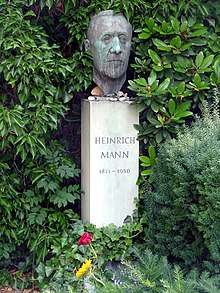Heinrich Mann

Luiz (Ludwig) Heinrich Mann (27 March 1871 – 11 March 1950) was a German novelist who wrote works with strong social themes. His numerous criticisms of the growth of fascism forced him to flee for his life after the Nazis came to power in 1933.
Early life
Born in Lübeck, as the oldest child of Thomas Johann Heinrich Mann and Júlia da Silva Bruhns, he was the elder brother of novelist Thomas Mann.[1] His father came from an affluent family of grain merchants and was a senator of the Hanseatic city. After the death of his father, his mother moved the family to Munich, where Heinrich began his career as a freier Schriftsteller (free novelist).
Work
Mann's essay on Émile Zola and the novel Der Untertan earned him much respect during the Weimar Republic, since they satirized German society and explained how its political system had led to the First World War. Later on, his book Professor Unrat was freely adapted into the movie Der Blaue Engel (The Blue Angel). Carl Zuckmayer wrote the script, and Josef von Sternberg was the director. The book's author wanted his girlfriend, the actress Trude Hesterberg, to play the lead, but Marlene Dietrich was given her first sound role as the "actress" Lola Lola (named Rosa Fröhlich in the novel).
Together with Albert Einstein and other celebrities in 1932, Mann was a signatory to the "Urgent Call for Unity", asking the voters to reject the Nazis. Einstein and Mann had previously co-authored a letter in 1931 condemning the murder of Croatian scholar Milan Šufflay.
Mann became persona non grata in Nazi Germany and left even before the Reichstag fire in 1933. He went to France where he lived in Paris and Nice. During the German occupation, he made his way through collaborationist Vichy France to Marseille, where he was aided by Varian Fry in 1940 to escape to Spain. He eventually escaped to Portugal and then to America.
The Nazis burnt Heinrich Mann's books as "contrary to the German spirit" during the infamous book burning of May 10, 1933, which was instigated by the then Nazi propaganda minister Joseph Goebbels.
Later life

During the 1930s and later in American exile, Mann's literary popularity waned. Nevertheless, he wrote Die Jugend des Königs Henri Quatre and Die Vollendung des Königs Henri Quatre as part of the Exilliteratur. The two novels sketched the life and importance of Henry IV of France and were acclaimed by his brother Thomas Mann, who spoke of the "great splendour and dynamic art" of the work. The plot, based on Europe's early modern history from a French perspective, anticipated the end of French–German enmity.
His second wife, Nelly Mann (1898–1944), committed suicide in Los Angeles. Heinrich Mann died in Santa Monica, California, lonely and without much money, just months before he was to move to East Berlin to become president of the German Academy of Arts. His ashes were later taken to East Germany and were interred at the Dorotheenstadt cemetery in a grave of honor.
Popular culture
Mann was portrayed by Alec Guinness in the 1992 television adaptation of Christopher Hampton's play Tales from Hollywood.
See also
References
- ↑ Liukkonen, Petri. "Heinrich Mann". Books and Writers (kirjasto.sci.fi). Finland: Kuusankoski Public Library. Archived from the original on September 4, 2013.
Further reading
- Gross, David: The Writer and Society: Heinrich Mann and Literary Politics in Germany, 1890-1940, Humanities Press, N.J., 1980, ( ISBN 0-391-00972-9)
- Mauthner, Martin: German Writers in French Exile, 1933-1940, Vallentine Mitchell, London, 2007, ( ISBN 978-0-85303-540-4).
- Walter Fähnders/Walter Delabar: Heinrich Mann (1871 - 1950). Berlin 2005 (Memoria 4)
- Heinrich Mann’s life in California during World War II, including his relationship with Nelly Mann, Thomas Mann and Bertolt Brecht, is a subject of Christopher Hampton’s play Tales from Hollywood, where he was played in film by Jeremy Irons (BBC Video Performance: “Tales from Hollywood”, 1992) and on stage by Kier Dullea (Guthrie Theater, Minneapolis, Minnesota, 2012).
External links
| Wikiquote has quotations related to: Heinrich Mann |